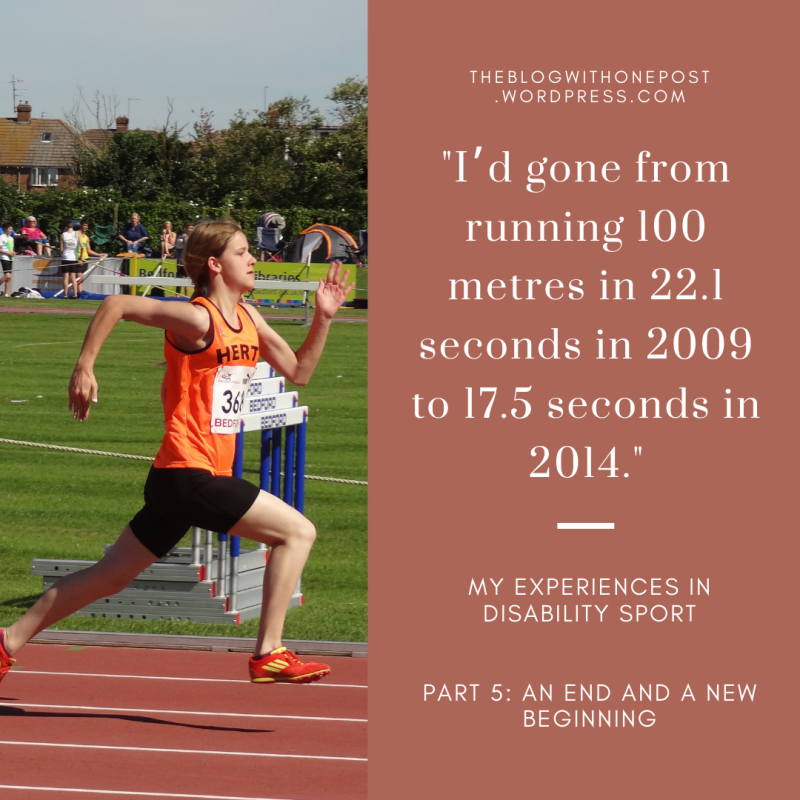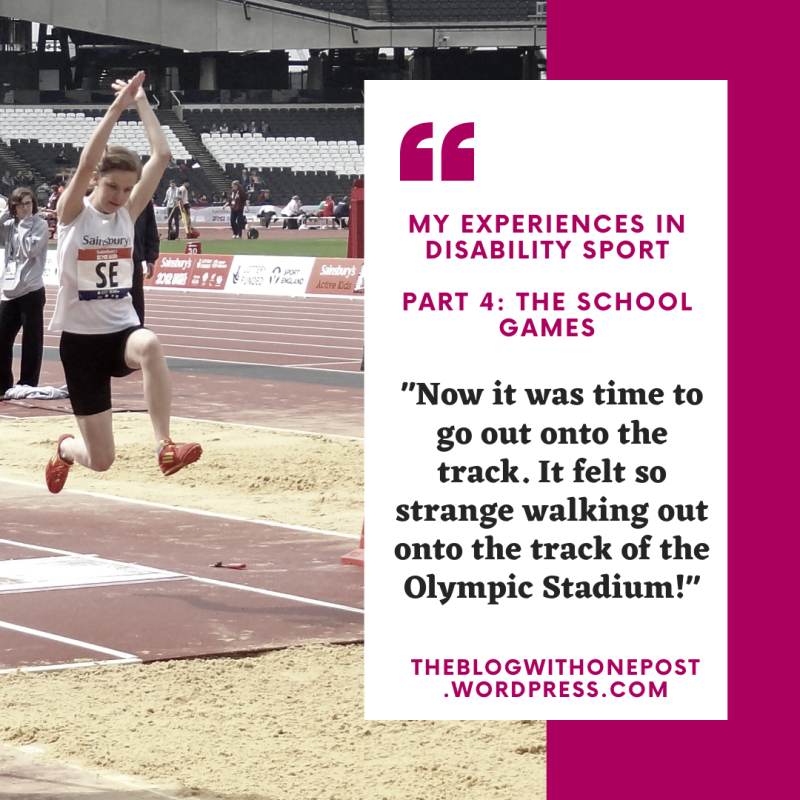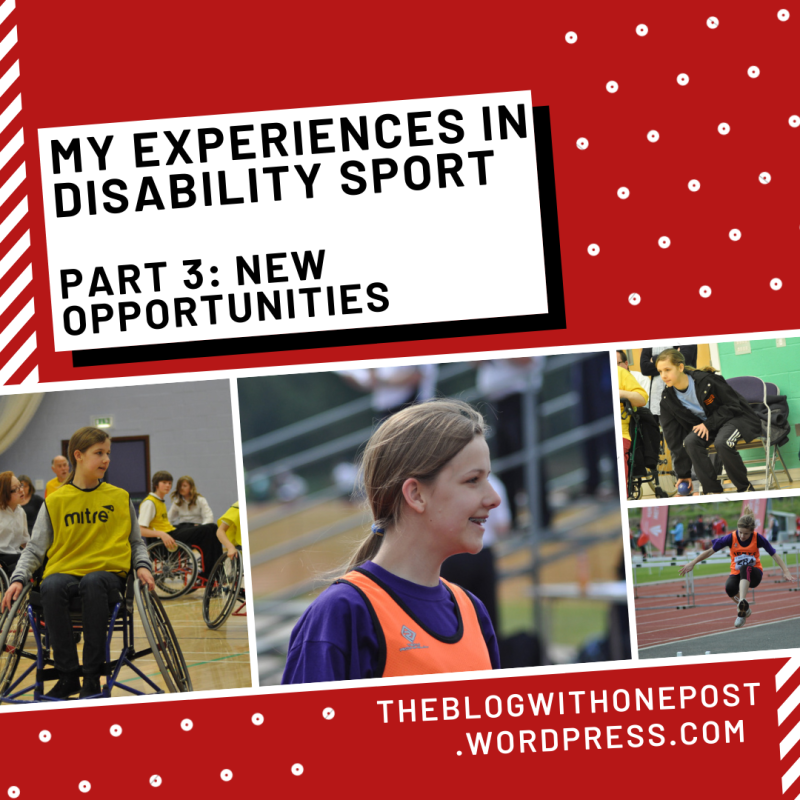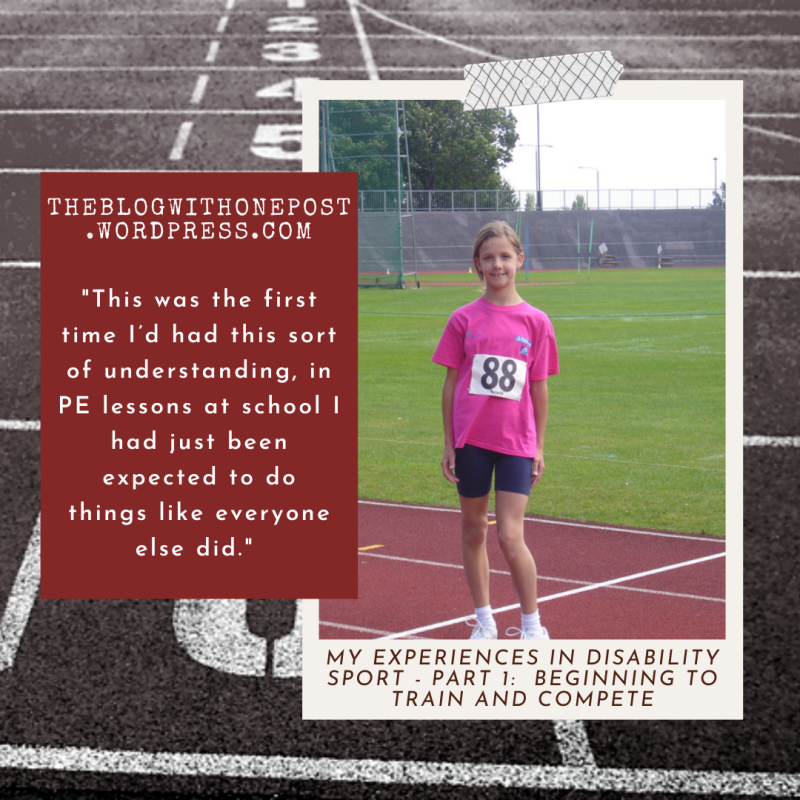Previous posts on disability sport:
After finding out that disability sport was something I enjoyed, I continued training during the winter. It did get very cold and I’d often be wearing about four layers! And that was with me running, let alone my Dad and brother who would often be sat in the stands! My brother was given the opportunity to get involved too though which was great – he even gave wheelchair racing a go!
I loved going training – it was somewhere where I made new friends, it built up my confidence and I was in an environment where I knew people wouldn’t judge me for struggling with certain things.
I remember one Monday evening when I had some homework to finish and I got so frustrated at the thought of having to miss training because of it, whereas if that had been a PE lesson I’d have felt differently! Although in year seven I did have an understanding PE teacher and some of my close friends were in my PE class – it was just most of the sports I didn’t like! One time, after completing the bleep test (most people hated this but I actually liked it as it was one of the few things I was alright at), my friends were talking to my PE teacher about how well I did with the bleep test considering my dyspraxia. My PE teacher agreed and mentioned how much more confident I was too. That goes to show the difference kind comments can make – the fact that I still remember the comment 12 years later!
I think the increased confidence was also to do with finally having some good friendships, as I had struggled a lot with making friends at the start of year seven. After I’d taken part in the regionals a few months earlier, one of my friends encouraged me to tell my PE teacher about it and my teacher put it in the school newsletter – which at the time was a big achievement! Unfortunately my PE teacher left and my second PE teacher wasn’t so understanding for quite a while. I remember when we did cross country and I came 10th or 11th out of about 30 people, which I was really pleased with but my PE teacher congratulated the person in front of me and not me, which did make me feel a bit left out and ignored!
When taking part in athletics, I received a grant from the local council to help me (well, my Dad really) with the cost of taking part in athletics. Back then I thought this meant paying for nice new kit but now I realise there was more to pay for than that! There was also petrol money for training, competition fees etc. When receiving our grant we attended a presentation and I remember asking my Dad beforehand “Will I have to say anything when I go up there?”. My Dad reassured me that he wouldn’t have thought I’d have to do that. To both of our surprise, when people were called up to collect their cheque they were asked questions about their sport in front of everyone! I wasn’t very prepared for this at all as it was unexpected but I managed to think of something to say. I received this grant for a few more years and at least in the following years I was prepared to answer questions!
After winter training had come to an end, I attended a multi-sports day at Lee Valley. This was aimed to give new people the opportunity to try out athletics, the same as I had been invited to the previous year. Whilst we were there we even happened to meet Dwain Chambers! I took part in a few training days and competitions at Lee Valley over the years and always enjoyed it there, such great facilities!
In 2010 I began to take part in a few more competitions, this time a much further distance (both in terms of the location of the competition and the event itself – I was taking part in 200m regularly now). I took part in competitions in Perivale, Nottingham, Wigan and Bath. These were all CP Sport competitions, so I competed as a guest again. This meant I wasn’t eligible for medals but it was great to have the opportunity to compete and try to beat my PB, especially as it was in such an inclusive environment. I managed to get my times down from the previous year and improve my long jump distance.
One thing I’ll never forget from this year is when we were staying in Wigan and the fire alarm went off in the middle of the night! We were all standing outside in our pyjamas whilst the fire brigade came (something had happened to one of the computers – thankfully all was okay though). I’m glad athletics competitions take place in the summer so it wasn’t too cold outside!
It was in 2010 when I saw a physio during some of my training sessions. She came to the athletics track during Monday’s training sessions and helped those of us in the disability squad with any injuries we may have had or helped us improve our balance, coordination etc. Whilst training, practice and exercises certainly don’t improve a disability itself, as the core part of the disability is always there, they can help us to perform certain tasks better.
After the physio and Ros had now seen more of how my disability affected me, Ros spoke to me about the fact that I may have mild cerebral palsy. She emphasised that this wouldn’t change anything about me, it was just another name for the difficulties I have. At first I was confused by this, the diagnosis of dyspraxia seemed to fit me well – how could I have cerebral palsy instead? I later realised that she meant both. Ros explained that other athletes had been in similar situations, where they had been initially diagnosed with dyspraxia and only later diagnosed with cerebral palsy. Me and my parents decided that it would be worth going to my GP about it, as perhaps I had been misdiagnosed/an additional diagnosis had been missed.
Later that same day, during the DSE Nationals, I had another DSE classification assessment. I’m still not quite sure why I had this – whether athletes with dyspraxia competing in DSE competitions need to be assessed more regularly or another reason. My classification was the same as it had been the previous year, a DSE profile 26; equivalent to a T36 on the track.
It was the following year when I found out that I did in fact have mild ataxic cerebral palsy, in addition to dyspraxia. At first this did confuse me a bit, as I’d always put everything down to dyspraxia. Since then I’ve understood it a bit better and actually blogged about the similarities and differences between dyspraxia and CP a few years later.
Now I had a diagnosis of CP, I was eligible for a national classification. This was more in-depth than the previous classification I’d had for DSE events. Although quite a few of the exercises I was asked to do for this were ones that I had previously practiced with the physio from athletics training, meaning that I was better at these exercises than I would have been on the first attempt! At the end of the assessment, I was told that they were going to classify me as a T/F38 (as I mentioned above, I had previously been a 36). When coming out of the assessment, my first thoughts were “Why did they change it? Everyone in this classification is so much quicker than me, it’s going to be really difficult!” At the time I couldn’t see why they had changed me from a 36 to a 38 and thought that the exercises I had been asked to do (which I had already practiced) had affected it. Looking back now, I can completely understand why I was classified as a 38.
The positive thing about having a national classification was that it meant I was able to take part in so many more competitions, which I’ll talk about more in my next post!
Natalie 🙂
Previous posts on disability sport: Disability Sport – A GlossaryDyspraxia and Disability Sport – An Introduction and a Guide to ClassificationMy Experiences in Disability Sport – Part 1: Beginning to Train and CompeteMy Experiences in Disability Sport – Part 2: Continuing Competing and A New DiagnosisMy Experiences in Disability Sport – Part 3: New OpportunitiesMy…
Previous posts on disability sport: Disability Sport – A GlossaryDyspraxia and Disability Sport – An Introduction and a Guide to ClassificationMy Experiences in Disability Sport – Part 1: Beginning to Train and CompeteMy Experiences in Disability Sport – Part 2: Continuing Competing and A New DiagnosisMy Experiences in Disability Sport – Part 3: New Opportunities…
Previous posts on disability sport: Disability Sport – A GlossaryDyspraxia and Disability Sport – An Introduction and a Guide to ClassificationMy Experiences in Disability Sport – Part 1: Beginning to Train and CompeteMy Experiences in Disability Sport – Part 2: Continuing Competing and A New Diagnosis As I mentioned in my previous post, having a…
Previous posts on disability sport: Disability Sport – A GlossaryDyspraxia and Disability Sport – An Introduction and a Guide to Classification During primary school I hated PE. I was slow at getting changed into my PE kit, I was slow at running, I struggled to catch a ball. I did not enjoy sports day at…
Previous post on disability sport: Disability Sport – A glossary Sport… something which seemingly involves good balance, coordination, motor skills, and spatial awareness. To some it may sound like a dyspraxic’s worst nightmare! This was the view I had of sport for quite a few years, up until I got into disability sport where the…








